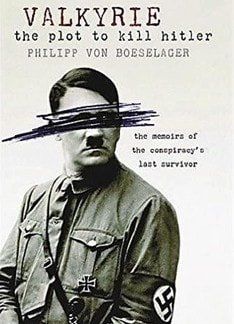The plethora of books about the Second World War, and especially Adolf Hitler and the Nazi regime in Germany, is indicative of an ongoing fascination with this subject, from both modern readers and authors. Far too many of these books, however, make the fallacious equation of ‘German = Nazi’.
This crisply written memoir of Philipp von Boeselager (1917–2008), published in the year after his death, is a helpful reminder that there were some in Germany who refused to go along with the crowd during the Nazi era, and sought to live honourable lives (p.166).
Hence the motto of the group of Germans with which Von Boeselager came to identify himself, Etiam si omnes, ego non! (‘Even if all, not I!’); a motto drawn from Matthew 26:33, in the Vulgate.
Born to Roman Catholic nobility in the Rhineland, Von Boeselager details the way that, growing up, he was particularly close to his older brother Georg (1915–1944). In fact, in some ways, this book is a panegyric of Georg, whose tremendous bravery as a soldier is variously depicted. Georg was decorated with the Iron Cross with oak leaves and possessed a deep sense of loyalty to the soldiers under his command.
But Philipp’s own bravery under fire is also quite remarkable. He was wounded five times in battle, once seriously; he nearly died and had to endure weeks of convalescence (pp. 46–48). And he was quite prepared on occasion to speak his mind publicly about his disagreement with Nazi policies (pp. 71–74, 158).
Philipp’s realisation of the depth of evil within the Nazi regime began when he had a conversation in June 1942 with an SS commandant named Erich von dem Bach-Zelewski (1899–1972), whom Von Boeselager does not hesitate to describe as ‘truly a creature of the devil’ (p.65).
When Bach-Zelewski casually mentioned his killing of five Roma, simply because of their ethnicity, and then went on to stress that ‘Jews and gypsies are among the Reich’s enemies. We have to liquidate them’ (pp. 66–67), Von Boeselager states that this conversation ‘changed my view of the war. I was disgusted and afraid’ (p.67).
This incident made Von Boeselager more than ready to join a circle of conspirators around General Hermann Henning von Tresckow (1901–1944), who were plotting to kill Hitler and stage a coup d’état; a circle that also included his brother Georg.
After the Allied invasion of France in summer 1944, it was obvious to men like Von Boeselager that the war was lost. Nonetheless, as Von Tresckow noted, the attempt to assassinate Hitler had to go ahead, for it was vital to ‘show the whole world and History that the German resistance movement dared to gamble everything, even at the risk of its own life’ (pp. 142–143).
It is noteworthy that Von Tresckow is depicted as a man ‘constantly admiring the work of his Creator’ and a committed Christian (pp. 81–82). Von Boeselager also reveals a genuine love for nature and animals (see, for example, his endearing discussion of the horses in his cavalry unit, on pages 90–91).
The decision to assassinate Hitler was not taken lightly, but involved lengthy discussions of the legitimacy of the act and ‘the justification for murder — for an assassination, even of a tyrant, remains a murder’ (p.87).
It also meant breaking with a long tradition of total obedience to the government, which was especially prevalent among the Prussians and was the regional background of Von Tresckow and a number of the conspirators (p.83).
Due to training that Von Boeselager had been given with explosives, and his subsequent access to them, he became the ‘conspiracy’s chief explosives expert’ (p.86). It was thus he who supplied the explosives used in the July 1944 attempt to kill Hitler (p.x).
Explosives were eventually deemed necessary, since Hitler used to wear a thin bulletproof vest and a cap lined with metal, making assassination with a pistol difficult (pp. 100–101).
The only Bible text explicitly cited in the memoir is from the Latin Bible that Von Boeselager regularly carried with him: ‘that we, being delivered from the hand of our enemies, might serve Him without fear’ (Luke 1:73).
With the failure of the July 1944 plot to kill Hitler, most of the conspirators were arrested and subsequently executed after frightful torture. Despite their being centrally involved, however, the Von Boeselager brothers escaped the notice of the SS.
On one occasion, though, in the month after the failed assassination, Philipp was ordered to come to army headquarters. He expected to be arrested and was understandably quite nervous. As he was boarding the plane to fly him back from the Eastern Front, his Latin Bible fell from a bag he was carrying.
Stooping to pick it up, Von Boeselager saw the verse noted above, and seems to have taken it as a sign that God would protect him, as he said to himself, ‘By the grace of God’ (p.155).
And, in some ways, this last phrase can be seen as a theme of Von Boeselager’s entire memoir, as he gives elegant witness to those who refused to acquiesce to the diabolical regime of Hitler and stood up for what was just and right.
Michael A.G. Haykin
Professor of church history, Southern Baptist Theological Seminary, Louisville, KY







